Here in the Metro Valley are West Virginia's largest cities which includes the state capital, Charleston, and Huntington. But it also includes some smaller towns such as Logan and Point Pleasant, where we will begin our visit. So let's get going.

In 1770 George Washington wrote in his diary of a place where the Kanawha and Ohio rivers flowed together. That place was
POINT PLEASANT
which is also where the very first battle of the American Revolution occurred.
Point Pleasant is probably best known for this particular battle. This monument, which has been erected in memory of this battle, is located in the Point Pleasant Battle Monument State Park.

The struggle began with European settlers hungry for land, and the Native Americans unwilling to give up their hunting grounds.Lord Dunmore was appointed British governor of Virginia in 1771.
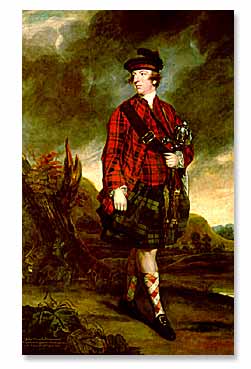
He was charged with discouraging settlement of the land beyond the Alleghenies, partly to honor the indians' right to their hunting ground, and partly to maintain a fur trade with the tribes.
But the settlers continued to cross the mountains, and the indians resisted.
The straw that broke the camels back was the slaughter of Mingo Chief Logan's entire family by drunken settlers. Up to this point, Logan was friendly with the whiteman.
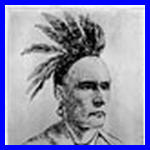
Chief Logan
In his grief and wrath, Chief Logan went on the warpath, and led many attacks against the settlers during the summer of 1774. Violence escalated from that time on.
The Battle
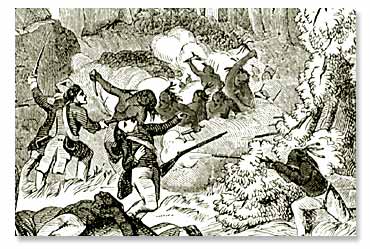
An artists rendering of the battle.
On October 10, 1774, the Virginia militiamen, (numbering 1,100),led by Colonel Andrew Lewis,
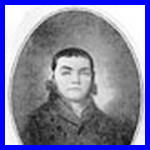
defeated the Shawnee Indians (of equal number) lead by Chief Cornstalk.

This broke the power of the indians in the Ohio valley and prevented an indian alliance with the British....one that might have altered the course of American history.

On our way to Huntinton, we are going to stop for a short time in
LESAGE
to visit the Jenkins Plantation Museum.
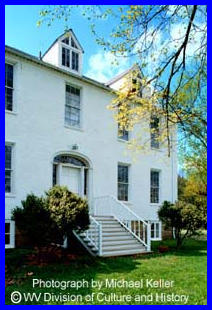
This house was built in 1835 by William Jenkins who lived here along the Ohio River with his wife, 4 children, and 55 slaves.
The house is most closely associated with his youngest son, Albert Gallatin Jenkins
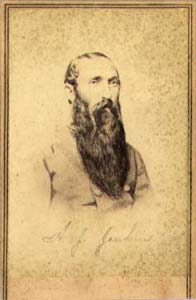
Dig that crazy beard who inherited the house and a third of the land when his father died in 1858.
He practiced law for a time and was elected to the U.S. Congress, a career that didn't last very long. He died at the age of 33 as a result of a wound received at the battle Cloyd's Mountain in 1864.
This place has so much activity, that I thought it would make a nice stop. But now, on to

HUNTINGTON

one of the largest cities in West Virginia.
This city was built by railroad magnate Collis P. Huntington

who built, owned and operated the Chesapeake and Ohio Railway. The location was ideal...close to timber tracts, coal fields, oil and natural gas deposits, and an important river connection with Cincinnati. He pushed his rail line thru the mountains linking it with the Union Pacific line thereby establishing the Transcontinental Railroad. In 1884, he rode his own railroad car from the Atantic Ocean to the Pacific over tracks he either owned or controlled....something no one else had ever done. The railroad brought prosperity to Huntington.
Even though Huntington has grown to be West Virginia's second largest city, as you walk the tree lined streets downtown, you get that "down home" feeling.
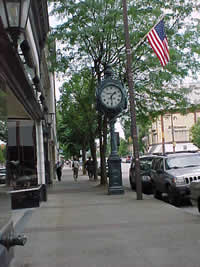
There are many things to see here such as the Keith-Albee Theatre.

Or we can take a walk through one of the beautiful parks.

We might even take a ride across the one mile long East End Bridge. This asymetrical bridge looks like a gigantic spider from overhead. It was the second concrete cable-stayed bridge erected in the country and the first to use high-strength concrete.
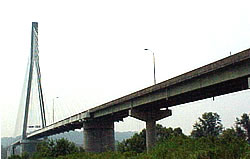
The bridge opened to traffic in August of 1985 after more than 20 years of planning and designing and 10 years of construction efforts. The cost of the bridge was 38 million dollars.
Let's go now to HERITAGE VILLAGE, a shopping and entertainment complex located in the former Baltimore and Ohio station. Heritage Village is home to an example of the kind of steam locomotive used during the city's heyday. You can even sit at the throttle of the old B&O 4559, a Mikado-class locomotive build in 1911. There's a lot to see here, but of course, I'm sure you know that just from the word complex....shopping anyone??? I've got an idea...Ladies, we'll go shopping and let the guys stay here and play with the trains. Sounds like a plan to me.
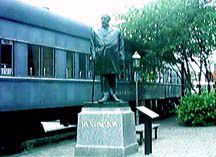
Oops, I almost forgot to tell you about this statue....This larger-than-life bronze likeness, created by Gutzon Borglum of Mt. Rushmore fame, is none other than Collis P. Huntington himself. The statue was moved from its original home several blocks away and donated to the city by the Huntington family. It stands on a granite pedestal in the courtyard of the Heritage Village.
Inside the boxcar are curio shops that we can browse through. Also in the plaza is the Bank of Huntington, which was the city's first bank.

This bank was robbed by the Jesse James Gang on Sept. 8, 1875. Legend has it that the gang fled into Kentucky and was never apprehended.
I would be amiss if I didn't mention that Huntington is home to Marshall University.
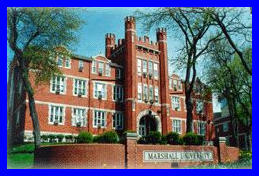
I also might mention that Marshall University is home to the Thundering Herd Football Team.
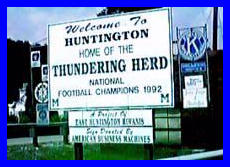
Marshall University also has on their campus a ONE-ROOM SCHOOLHOUSE. This schoolhouse provides a unique and effective way for residents of the tri-state area of Ohio, Kentucky, and West Virginia to learn about and celebrate one aspect of their Appalachian heritage.
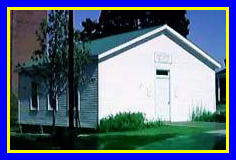
The school building dates back to 1889. Union School, nicknamed "Punkin Center" School, was moved to Marshall's campus in Huntington in 1994, and was restored to preserve the original features of the building.
The school provides an opportunity for children to observe first-hand the one-room school experience of past generations.
I might interject here that we visited the one-room schoolhouse here in Fort Lauderdale, Florida, on a field trip. It was a lot of fun. The kids did different activities and since it was a mixture of all ages and grades, the older kids helped the younger ones.
Since we just got out of school, I thought we might go to the park. Hey, what kid would refuse a trip to the park?
Camden Park
Camden Park has been West Virginia's only amusement park since 1902. It's a small amusement park with over 30 rides, including a log flume, the Thunderbolt Express, and a wooden roller coaster - The Big Dipper. There's something there for young and old alike. So for an old time good time, this is the place to go.

During summer the park hosts country music shows. Many country singers performed at Camden Park very early in their careers, making Huntington residents among the first to see them "before they were stars".

Well, I hope everyone had a good time, but it's time to move on. Click on the license plate below and see where we will go next.
